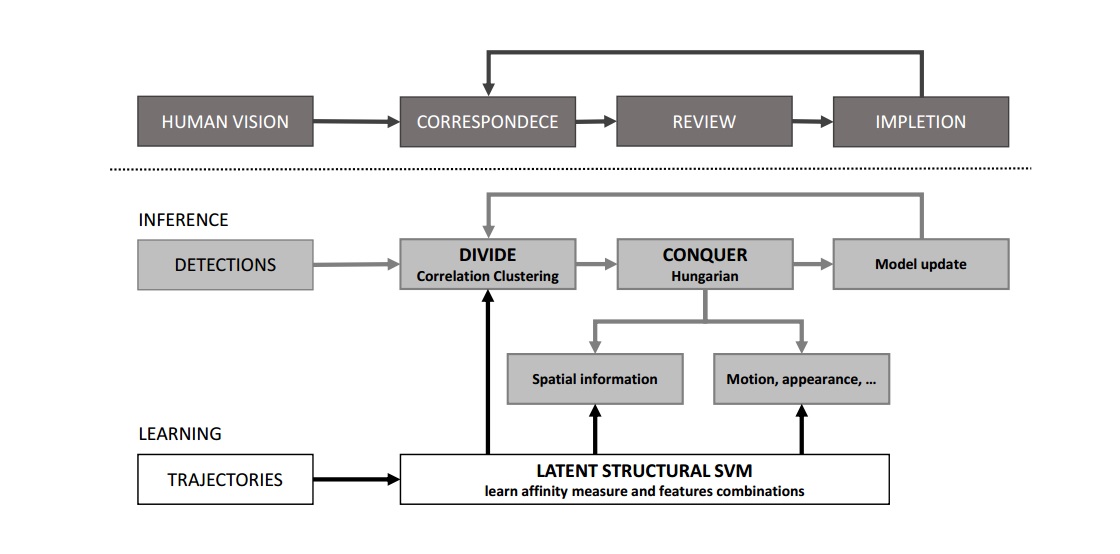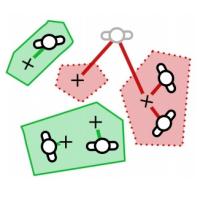

Multiple People Tracking
Multiple Target Tracking is an important task within the field of computer vision. The proliferation of high-powered computers, the availability of high quality and inexpensive video cameras, and the increasing need for automated video analysis has generated a great deal of interest in tracking algorithms. The problem is often addressed in a paradigm named tracking-by-detection, where detections are given ahead of time and tracking purpose is to merge this detections into separate identities. The real challenge in Multi Target Tracking is how to deal with noisy detections (miss and false detections) and with long occlusions. In this work we leveraged on cognitive psychology studies to develop a human-inspired model.

The proposed method relates the 3 steps of correspondence, review and impletion (borrowed from cognitive psychology) to a divide and conquer approach. Targets are divided in the where pathway by checking for incongruences in spatial coherence. Eventually, the tracking solution is conquered by associating coherent elements in the where (spatial) domain and incoherent ones in the what (visual) domain.
The core of the proposal is twofold. First, a method to divide potential associations between detections and tracks into local clusters or zones. A zone can be either simple or complex, calling for different features to complete the association. Targets can be directly associated to their closest detections if they are inside a simple zone. Conversely, targets inside complex areas are subject to a deeper evaluation where appearance, motion and other features may be involved. Second, we cast the problems of splitting potential associations and solving them by selecting and weighting the features inside a unified structural learning framework that aims at the best set of partitions and adapts from scene to scene.

Evaluation of Reproducible Robustness
We further investigate the evalution of TBD systems, which is a challenging task itself. Conventional experiments on MTT are built upon the belief that fixing the detections to different trackers is sufficient to obtain a fair comparison. Instead, we argue how the true behavior of a tracker is exposed when evaluated by varying the input detections rather than by fixing them. We propose a systematic and reproducible protocol and a MATLAB toolbox for generating synthetic data starting from ground truth detections, a proper set of metrics to understand and compare trackers peculiarities and respective visualization solutions.

Multi Target Tracking and Evaluation Pages and Codes
URL: https://github.com/francescosolera/LDCT
URL: http://imagelab.ing.unimore.it/tbd-evaluation
Publications
| 1 |
Solera, Francesco; Calderara, Simone; Cucchiara, Rita
"Towards the evaluation of reproducible robustness in tracking-by-detection"
AVSS 2015 : 12th IEEE International Conference on Advanced Video and Signal-Based Surveillance : August 25-28, 2015, Karlsruhe Institute of Technology & Fraunhofer IOSB, Karlsruhe, Germany,
Karlsrhue (Germany),
pp. 1
-6
,
25-28 August,
2015
| DOI: 10.1109/AVSS.2015.7301755
Conference

|
| 2 |
Solera, Francesco; Calderara, Simone; Cucchiara, Rita
"Learning to Divide and Conquer for Online Multi-Target Tracking"
2015 IEEE International Conference on Computer Vision,
vol. 11-18-December-2015,
Santiago (Chile),
pp. 4373
-4381
,
11-18 December 2015,
2015
| DOI: 10.1109/ICCV.2015.497
Conference

|
